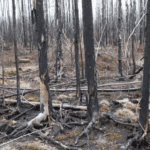For this Women-in-Science post, I wanted to talk to a woman in science about her own personal experiences. While this is by no means representative of the experience of all women in science, it provides a glimpse into one personal story and career trajectory, and gives us a window into potential ways in which we help – or hinder – women in science. For girls and women interested in science, this post is intended to help them better understand what that career path might look like.

Image: The Oshawa Express
Our interviewee is Dr. Andrea Kirkwood, an Associate Professor of Biology at the University of the Ontario Institute of Technology (UOIT) in Oshawa. Andrea has a BES in Environment & Resource Studies and Biology from the University of Waterloo, an MSc in Aquatic Ecology from McMaster, and a PhD in Environmental Microbiology from the University of Toronto. She spent five years as a postdoctoral fellow at Oklahoma State University and then the University of Calgary. It was in Calgary that she first got involved in research on didymo (Didymosphenia geminata, or toilet paper algae), a nuisance alga in the Bow River near Banff and Canmore, Alberta. She has published in Canadian Science Publishing’s Canadian Journal of Fisheries and Aquatic Sciences (CJFAS) and Canadian Journal of Microbiology (CJM), among other peer-reviewed journals.
In an unflinching look at her career path and choices, Dr. Kirkwood feels she hasn’t experienced overt discrimination during her career. She attributes this to being single much of the time and therefore not having to make tough family choices – choices for which she may have been judged by colleagues and/or the academic system as not being a ‘serious’ scientist.
“Although singledom was not a conscious choice, I’m the first to admit that it afforded me the freedom to pursue my academic career interests…Had I met my partner much earlier on…I’m sure I would’ve had to make some career sacrifices to accommodate my spouse’s career and having kids.” Now that she has a son (and another child on the way!), Kirkwood has had to adjust her approach to academic life, and has found that having spousal support and an extended family that’s willing to help has been essential.
So what changes when you have kids? Well, Kirkwood does fieldwork locally to avoid being away from home for more than a day, and she books only one big conference a year during a time when her spouse can help out with childcare. She also schedules lab visits to other universities around times when her spouse and extended family can help with child care. Teaching schedules can also be difficult– especially if you’re expected to teach night classes.
Though she’s heard more horror stories than she’s experienced personally, Kirkwood notes that things have improved for women in STEM even during her time in academia, including policies regarding tenure and grant eligibility for women on maternity leave. With NSERC grants, for example, “not only is maternity leave taken into account for loss in productivity time, but they also offer a grant extension and support for up to two years for certain leaves.”
Kirkwood realizes, however, that academia is not a meritocracy. “It’s not just about submitting a great proposal, but reputation, seniority, and even gender come into play during the grant selection process,” she says. Some research handicaps other than gender will be beyond your control, including lack of a research ‘pedigree,’ being a single researcher instead of part of a research group, or being an ‘outsider’ to a particular research field. You need to be prepared to put in the necessary hard work to become an expert, not just someone who’s interested in a topic – and that requires determination, self-esteem, and hard work.
She notes that imposter syndrome can be a ‘real and present danger’ to success in a scientific career, and recommends that girls address it early by challenging themselves to fail, and accepting that failure. On a related note, she cautions women not to be discouraged by low grades in math-related courses. “I recently told my niece, who wants to be a marine biologist, not to stress over first year Calculus and Physics. Even if they aren’t her best grades, they won’t define her abilities as a biologist. Girls in particular may shy away from the sciences because of their perceived abilities in math, and I want to reassure them that they can still be a great scientist without being a math prodigy.”
So what does a scientist look like as a child? “I spent entire summers at the family cottage in Haliburton with one fuzzy TV channel and no motorized water toys. I entertained myself by catching frogs and salamanders, exploring the forest on foot, or the inlets and wetlands by canoe. On rainy days, I was an avid reader of Farely Mowat and ‘Choose your Own Ending’ adventure books.” One of Kirkwood’s early heroes was David Suzuki, and when she was eight her mother said she thought Kirkwood would be a scientist when she grew up. It wasn’t until her teens, though, that she saw women role models in science, like Diane Fossey and Jane Goodall.
But while the seeds of a science career were planted in Kirkwood’s mind from an early age, she realizes that a science career can also develop from serendipity. By working on topics related to her main research program – even if they weren’t exactly her main research area – Kirkwood was able to generate opportunities and fulfill her mother’s prediction that she would become a scientist.
She cautions, however, that academia is not the only route to being a scientist. Many of her female friends and colleagues left the university system after a PhD or a postdoc, and are doing great work outside the academy. While Kirkwood doesn’t believe in the mantra of ‘following your passion,’ she feels that being passionate about your research topic will help motivate you to get over the rough spots during your career, while also being open to unexpected career trajectories. “Having a career goal is fine, and doing your best to pursue that goal is highly advisable. However, life happens and things beyond your control happen (e.g., cuts in research funding), so be prepared for alternative career paths. This involves learning about other science careers and networking with scientists in those careers.”
Read more from Dr. Kirkwood and her thoughts on being a Jack-of-all-Trades, master of none at Small Pond Science. Also see posts from Calgarian Carla Davidson on a non-traditional career in science, and my post about science versus science writing careers. Other good resources for careers as women in academia include Tenure She Wrote and Hook & Eye. For an excellent background on how we collect and analyse data on gender bias in science, see Theresa Liao’s series of posts over at Science, I Choose You. For more general issues around women in science, follow Curt Rice and Athene Donald both at their blogs and on Twitter. For science stories from a woman’s perspective, try LadyBits, a group out of the Popular Science outlet in the US, and Double X Science.
Further reading:
Old Boys’ Lab: Where are the women in America’s greatest scientific laboratories? By Jane Hu
Women are underrepresented in big NSERC awards By Alex Bond




